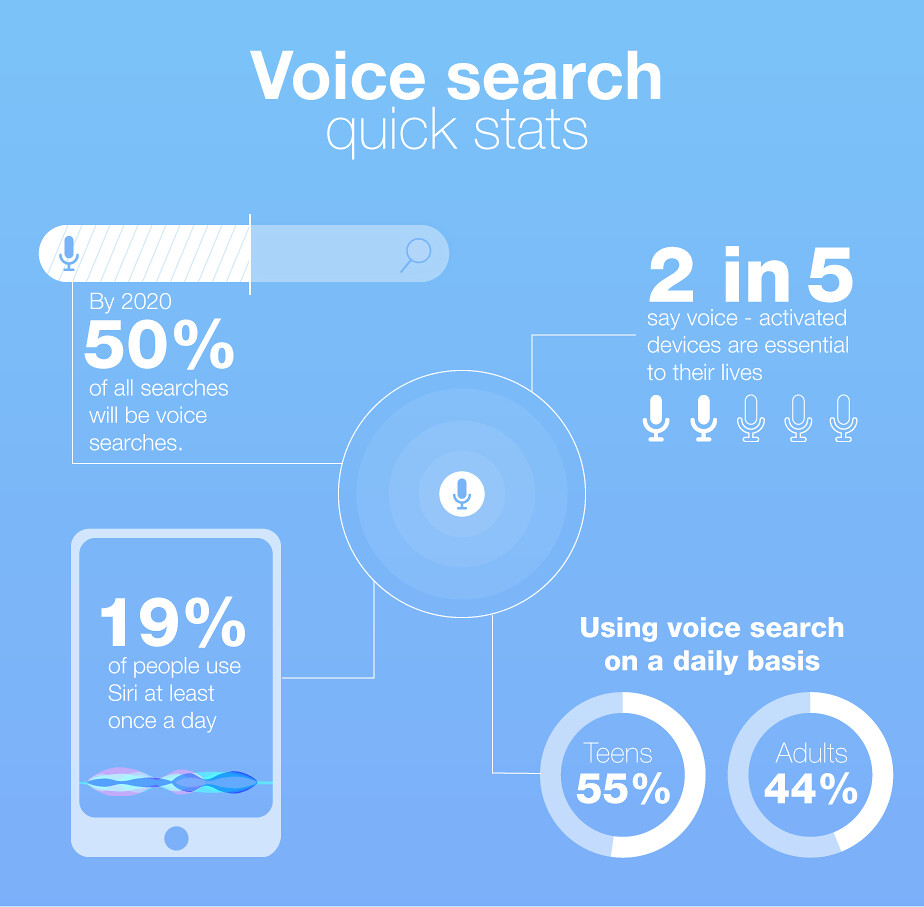Are you tired of tirelessly typing away at your keyboard, desperately hoping it will understand what you’re trying to say? Well, worry no more! Enter the era of voice search optimization, where your words come to life with a simple command. In a world that values convenience and efficiency, voice search optimization is progressively becoming an essential tool in the digital landscape. By harnessing the power of our voice, we are unlocking a realm of possibilities that will revolutionize the way we interact with technology. So, get ready to explore this fascinating phenomenon, as we delve into the world of voice search and discover how it’s reshaping our online experiences.
Table of Contents
- Introduction to Voice Search Optimization
- Understanding the Rise of Voice Assistants
- Why Voice Search Optimization Is Essential for Businesses
- Harnessing the Power of Natural Language Processing
- Optimizing Content for Voice Search: Best Practices
- Technical Considerations for Voice Search Optimization
- Measuring Success in Voice Search Optimization
- Future Trends in Voice Search Optimization
- Q&A
- Future Outlook
Introduction to Voice Search Optimization

Voice Search Optimization has become an essential strategy for businesses in the digital age. With the rise of smart devices and virtual assistants, such as Siri and Alexa, voice search has gained tremendous popularity among users. In this post, we will dive into the world of voice search optimization and explore how it can benefit your website and online presence.
One of the key advantages of voice search optimization is its convenience and ease of use. Gone are the days of typing lengthy search queries; now, users can simply speak into their devices and get instant results. This hands-free approach to searching has revolutionized the way people interact with technology, making it essential for businesses to adapt their SEO strategies accordingly.
When optimizing for voice search, it is crucial to understand the differences in user behavior compared to traditional typed searches. Users tend to use more conversational language and ask specific questions when using voice search. Therefore, it is important to focus on long-tail keywords and phrases that match the natural language patterns used in voice queries. By leveraging these targeted keywords, your website can have a better chance of appearing in voice search results and gaining valuable organic traffic.
Understanding the Rise of Voice Assistants

As technology continues to advance, we are witnessing a rise in the popularity of voice assistants. These intelligent virtual assistants, such as Siri, Alexa, and Google Assistant, have become an integral part of our daily lives. People are relying on voice search more than ever before, making it crucial for businesses to understand the rise of voice assistants and optimize their online presence for this growing trend.
One of the key factors driving the rise of voice assistants is their convenience. With voice search, users can simply speak their queries instead of typing them out, making the whole process faster and more efficient. Additionally, voice assistants allow for hands-free interaction, enabling users to multitask while accessing information or performing tasks. This convenience factor has contributed to the widespread adoption of voice assistants across various devices, from smartphones to smart speakers.
Another reason behind the popularity of voice assistants is their advanced natural language processing capabilities. These virtual assistants can understand and interpret human language, making it easier for users to communicate naturally without having to use specific keywords. Search queries are now more conversational and context-based, often resembling a conversation rather than a command. Understanding the nuances of natural language is essential for businesses aiming to optimize their content for voice search.
Why Voice Search Optimization Is Essential for Businesses

In the bustling world of digital marketing, businesses are constantly striving to stay ahead of the game. One emerging trend that cannot be overlooked is voice search optimization. With the rise of voice-activated assistants like Siri, Alexa, and Google Assistant, consumers are increasingly using their voices to search for information rather than typing on a keyboard. This paradigm shift has significant implications for businesses and their online presence.
First and foremost, voice search optimization can greatly enhance a business’s visibility in search engine results. When a user performs a voice search, search engines strive to provide the most accurate and relevant answer. By optimizing your website’s content for voice search queries, you increase the likelihood of your business being featured as the coveted featured snippet. This prime real estate at the top of search results can significantly boost your brand’s visibility and organic traffic, ultimately leading to higher conversion rates.
Additionally, voice search optimization allows businesses to tap into the rising trend of local search. Studies suggest that a significant percentage of voice searches have “near me” intent, signaling a strong desire for location-specific results. By optimizing your website and online listings for local keywords and phrases, you position your business as a top contender when users ask voice-activated assistants for recommendations in their vicinity. Harnessing the power of voice search can thus drive foot traffic to your brick-and-mortar store and help you establish a stronger local presence.
Harnessing the Power of Natural Language Processing
![]()
Natural Language Processing (NLP) holds tremendous potential in revolutionizing voice search optimization. By harnessing the power of NLP, businesses can create a seamless and intuitive experience for users, allowing them to interact with technology in a more natural and conversational manner.
One of the key benefits of NLP in voice search optimization is its ability to understand and interpret human language in all its complexity. NLP algorithms can analyze spoken queries and accurately decipher the user’s intent, enabling more accurate and relevant search results. This means that businesses can optimize their content to align with the specific language patterns and phrases commonly used in voice search queries.
In addition, NLP can also help improve voice search accuracy by taking contextual cues into account. For instance, if a user asks, “What’s the weather like today?”, NLP algorithms can understand that the word “today” refers to the current date and provide real-time weather information. This contextual understanding allows businesses to tailor their responses based on the user’s location, time, and other relevant factors, delivering more personalized and precise results.
Embracing the power of NLP in voice search optimization enables businesses to stay ahead of the curve and provide a more satisfying user experience. By optimizing their content for voice search queries and incorporating natural language understanding, businesses can enhance customer engagement, increase brand visibility, and drive higher conversion rates. As NLP technology continues to advance, the possibilities for leveraging its power in voice search optimization are virtually endless, opening new doors for businesses ready to embrace the future of search.
Optimizing Content for Voice Search: Best Practices

In today’s digital era, voice search is becoming increasingly popular. With the rise of smart speakers and virtual assistants like Siri and Alexa, optimizing your content for voice search has become essential. Voice search optimization involves tailoring your website and its content to better suit the way people speak and search verbally. By understanding and implementing the best practices for voice search optimization, you can significantly improve your chances of being found by voice search users.
One of the key areas to focus on when optimizing your content for voice search is keyword research. Voice searches are often longer and more conversational than traditional text searches. Therefore, it’s crucial to identify long-tail keywords and phrases that people are likely to use when speaking. Consider using tools like Google’s Keyword Planner or SEMrush to find relevant keywords that have high voice search volume. Incorporate these keywords naturally into your content to increase its visibility for voice search queries.
Another important aspect of voice search optimization is creating content that directly answers questions. When users turn to voice search, they often have specific questions in mind. To cater to this, structure your content in a way that provides concise and clear answers to common questions related to your industry or niche. Use headings and subheadings to separate different questions and their answers, making it easier for voice search algorithms to identify and present your content as a source of valuable information.
Technical Considerations for Voice Search Optimization

Voice search is rapidly becoming the go-to method for obtaining information, with more and more people using virtual assistants like Siri, Alexa, and Google Assistant. As a result, businesses and websites must adapt their optimization strategies to accommodate this emerging trend. When it comes to voice search optimization, there are several technical considerations that play a crucial role in ensuring your content ranks high and remains easily discoverable.
Firstly, it is essential to understand that voice searches are typically longer and conversational compared to traditional text-based queries. This means that optimizing your content with long-tail keywords and natural language patterns is paramount. By including phrases and questions that mirror how people speak in real life, you increase the likelihood of your content being recognized as relevant and appearing in voice search results.
Furthermore, schema markup is a powerful tool that should not be overlooked when optimizing for voice search. Adding structured data to your website provides search engines with additional context, enabling them to interpret and present your content more accurately. Utilizing schema markup for crucial elements such as business information, FAQs, and product details can significantly enhance your chances of being featured as a voice search result. Remember to use appropriate schema types and provide comprehensive yet concise information to maximize visibility.
Lastly, website speed and mobile-friendliness are crucial factors for voice search optimization. Since voice searches are typically performed on-the-go, ensuring your website is mobile-friendly and loads quickly is essential for a positive user experience. Optimizing images, utilizing caching techniques, and compressing data can help reduce page load times. Additionally, implementing responsive design and using structured data to create a mobile-friendly site will further enhance your website’s performance and increase its compatibility with voice search algorithms.
In conclusion, to effectively optimize for voice search, businesses need to consider the unique technical aspects associated with this emerging trend. Incorporating long-tail keywords, leveraging schema markup, and prioritizing website speed and mobile-friendliness are crucial steps to ensure your content ranks high and remains visible in the growing voice search landscape. Stay ahead of the curve by implementing these technical considerations and capitalize on the significant opportunities voice search presents for your business.
Measuring Success in Voice Search Optimization

In the fast-paced world of digital marketing, staying on top of emerging trends is crucial. With the rise of voice search technology, businesses are starting to recognize the importance of optimizing their content for voice search. However, measuring the success of voice search optimization can be a bit tricky. In this post, we will explore different metrics and strategies that can help you measure the effectiveness of your voice search optimization efforts.
1. Increased website traffic:
One of the key indicators of success in voice search optimization is an increase in website traffic. With a well-optimized website, your chances of appearing in voice search results improve significantly. Measure your website traffic through tools like Google Analytics and track the percentage of voice search visitors over time. A steady growth in voice search traffic can indicate that your optimization strategies are paying off.
2. Conversion rates:
Ultimately, the success of any marketing effort is determined by its impact on conversions. Voice search optimization should ultimately drive more conversions and leads to your business. Keep an eye on your conversion rates and compare them before and after implementing voice search optimization. If your optimization efforts are effective, you should see an increase in conversion rates from voice search visitors.
3. Featured snippets:
Featured snippets are highly sought after in voice search results. When users ask a question, a featured snippet provides a concise answer at the top of the search results. Monitor your website’s appearance in featured snippets and track the click-through rates. The more often your content is featured, the higher the chances of attracting voice search users to your website.
Future Trends in Voice Search Optimization

As technology continues to evolve, voice search optimization is set to become increasingly important in the digital landscape. With the rise of virtual assistants like Siri, Alexa, and Google Assistant, people are relying on voice commands more than ever before. This shift has significant implications for businesses and marketers who need to adapt their strategies to ensure they remain visible in search results. Let’s explore some that can help you stay ahead of the game:
1. Local Optimization: With the growing use of voice search for local queries, optimizing your website for local queries will be essential. Focus on including location-specific keywords, optimizing your Google My Business listing, and ensuring your website provides accurate and up-to-date information about your location and opening hours. Local businesses can also benefit from creating content that addresses specific questions users may ask when looking for products or services in their area.
2. Featured Snippets: With voice search, search engines often provide users with a single, spoken answer, known as a featured snippet. To increase your chances of being chosen as the featured snippet, focus on providing clear and concise answers to commonly asked questions in your content. Structure your content with headers, bullet points, and numbered lists to make it easier for search engines to understand and extract valuable information to display as the featured snippet.
3. Conversational Keywords: Voice searches tend to be more conversational and natural compared to typed searches. To optimize for voice queries, focus on incorporating long-tail conversational keywords into your content. Consider how people would ask questions verbally and create content that addresses those queries. This approach will help your website rank higher in voice search results and improve user experience by providing direct and relevant answers to users’ questions.
Q&A
Q: What exactly is voice search optimization?
A: Voice search optimization refers to the process of optimizing your online content to be easily understood and discoverable by voice assistants like Siri, Google Assistant, or Amazon’s Alexa. It involves adapting your website, blog, or any other digital platform to deliver relevant information effectively when users perform voice searches.
Q: Why is voice search optimization important in today’s digital landscape?
A: With the rise in popularity of voice-enabled devices, such as smartphones, smart speakers, and even smart TVs, voice search has become an integral part of how users interact with technology. People are now using voice commands to search for information, make inquiries, or even complete transactions. Therefore, optimizing your content for voice search ensures that your business or brand remains visible to this growing audience.
Q: How can voice search optimization enhance the user experience?
A: Voice search optimization focuses on delivering quick and concise answers to users’ inquiries. By tailoring your content to match the way people naturally speak, you create a seamless and effortless user experience. This not only increases user satisfaction but also helps build trust and engagement, potentially leading to improved website traffic and conversions.
Q: What are some key strategies for effective voice search optimization?
A: There are several strategies you can employ to optimize for voice search. Firstly, it is crucial to use conversational language in your content, as people tend to ask questions using natural speech patterns. Secondly, identifying and targeting voice search keywords is essential. These typically include longer-tail and more specific phrases used in spoken queries. Additionally, ensuring your website loads quickly, has a mobile-friendly design, and provides direct answers to commonly asked questions can significantly improve voice search optimization.
Q: How does voice search optimization impact SEO (Search Engine Optimization)?
A: Voice search optimization complements traditional SEO practices but requires additional considerations. Since voice search queries are often longer and more conversational, it is necessary to optimize for natural language queries and employ language similar to how users speak. Additionally, appearing in the featured snippets (answer boxes) of search engine results can increase the chances of being selected as the voice assistant’s response, enhancing search visibility and boosting traffic.
Q: Can voice search optimization benefit local businesses?
A: Absolutely! Voice search is especially crucial for local businesses, as people often rely on voice assistants to find nearby services, stores, restaurants, or events. Optimizing your local business profiles, including accurate and up-to-date information such as address, phone number, and hours of operation, can help improve voice search visibility for potential customers in your area.
Q: Is voice search optimization a one-time process, or does it require continuous effort?
A: Voice search optimization is an ongoing process. As voice technology continues to evolve and improve, staying up-to-date with the latest trends and adapting your content accordingly is crucial. Regularly monitoring and analyzing the effectiveness of your voice search optimization efforts, as well as keeping up with emerging voice search features and best practices, will help ensure your content remains optimized and relevant for voice assistant users.
Q: Are there any potential challenges associated with voice search optimization?
A: While voice search optimization presents exciting opportunities, there are a few challenges to be aware of. Aside from the constant need to adapt to evolving technology, accurately predicting users’ conversational queries and understanding their search intent can be tricky. Furthermore, voice search optimization might require rethinking traditional content presentation, as search engines often provide direct answers without requiring users to click through to your website.
Q: What additional resources are available for those interested in voice search optimization?
A: There are numerous online resources, blogs, and industry publications that provide valuable insights and best practices for voice search optimization. Additionally, search engine companies and voice assistant developers frequently release guidelines and resources to help website owners adapt their content effectively. Staying connected to the latest trends and resources within the field is essential for successful voice search optimization.
To Wrap It Up
As we blissfully bid adieu to this voyage through the realm of voice search optimization, we are left with a symphony of possibilities lingering in the air. With every word uttered and every command voiced, the future of digital interaction transforms before our very eyes.
No longer are we confined to the limitations of keyboards and touchscreens; the era of voice search has emerged, championing convenience and efficiency in every syllable. The electronic symphony of seamless dialogue has enveloped our daily lives, revolutionizing the way we seek information and connect with our devices.
As this article draws to a close, let us not forget that the art of voice search optimization is an ever-evolving endeavor. In this ever-shifting technological landscape, it is imperative for businesses and individuals alike to orchestrate their presence to resonate harmoniously with these vocal arrangements.
Let us embark upon a journey where voices hold the power to sway algorithms and captivate an audience with sheer sonic prowess. Through understanding the nuances and intricacies of voice search optimization, we can tether our dreams to the melodious cadence of progress.
So, dear reader, as you find yourself at the end of this discourse, take with you the illuminating knowledge that awaits and traverse this digital soundscape with audacious determination.
For the harmonious future beckons, where searches are effortlessly spoken, and the symphony of voice search optimization plays on, enchanting us all with its irresistible melody.
Farewell for now, as we eagerly await the next crescendo in this captivating symphony of vocal exploration.

